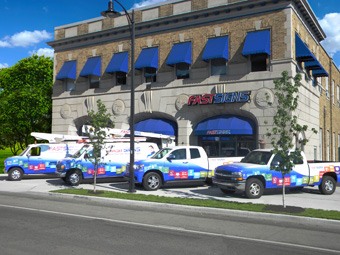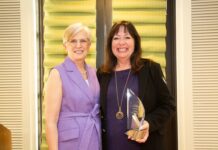 Sign makers looking to start up their own business or revitalize an already-existing establishment sometimes join a franchise network to help them do so. Although there isn’t complete independence, sign professionals can take assurance in a support system that’s designed to help them in many different ways—marketing, management, production, etc.
Sign makers looking to start up their own business or revitalize an already-existing establishment sometimes join a franchise network to help them do so. Although there isn’t complete independence, sign professionals can take assurance in a support system that’s designed to help them in many different ways—marketing, management, production, etc.
While the franchise life isn’t necessarily for everyone, let’s take a closer look at how one long-time sign shop owner successfully made the transition. (Note: The following story is the unabridged version of an article appearing on page 52 of the February 2013 issue of Sign Builder Illustrated.)
Al’s Sign Service in Erie, Pennsylvania had been in business since 1940. Dan Stutzman and his wife Naomi were the fourth set of owners. Although the shop had a good client base, they only had a few employees, no Internet presence, and no effective marketing. They were relying on already-existing instead of up-and-coming (in terms of clients and technologies).
Dan Stutzman had taken notice of the different franchises that were already operating in the area. “When I would visit a customer to talk with them about a sign, I’d notice that the other franchise shop would have their professional-looking brochure already sitting on the customer’s desk,” he says, “and I didn’t have anything like that to leave with them.”
The Stutzmans knew they didn’t have the resources to take Al’s Sign Service to the next level, so six years ago, they made the decision to convert the business into FASTSIGNS® Erie. http://www.fastsigns.com/514 “The conclusion was unanimous,” says Dan. “If you can’t beat them…join them!”
 Stutzman already had experience building illuminated sign cabinets and installing channel letters, but now as part of the FASTSIGNS family, Stutzman and his team are able to work a wide variety of projects. “You never stop learning in this business, especially since the technology is coming at you full speed,” he says.
Stutzman already had experience building illuminated sign cabinets and installing channel letters, but now as part of the FASTSIGNS family, Stutzman and his team are able to work a wide variety of projects. “You never stop learning in this business, especially since the technology is coming at you full speed,” he says.
Today Stutzman’s operation has increased its knowledge of the sign business, boasts a professional-looking Web site, expanded to nine employees, and features some 10,000 square feet of space in its freestanding downtown location.
The Conversion Decision
Since Al’s Sign Service had been a respected name in the community and been in business in the same downtown area for over seventy-two years, Stutzman was obviously concerned with how his loyal customers were going to react to this professional decision. “But we tripled our business the first year after converting,” he says.
After signing the agreement with FASTSIGNS® International, Inc., it took about four months to make the changeover. One thing Stutzman had to undertake during this timeframe was making sure his store fell in line with the required décor specs—the front counters, the carpet, the wood flooring, the colors of the wall, etc.
Stutzman also took this opportunity to double the size of his showroom. “We never really had a clear direction as to our shop’s theme. I didn’t have good samples on the walls,” he says. “Organization was also a problem. Customers coming in would either have to walk around a sign that was waiting to go out the door or step over three or four rolls of vinyl that UPS had just dropped off.”
Now there’s a shipping and receiving area out of the customers’ view, and the showroom is always presentable and “tour ready.”
{2j_imageviewer 30}
Stutzman finds that both his previous and now new customers have been responsive to this cleaned-up look. “You can tell when they walk into our showroom and look around that they’re done shopping,” he says. “I believe they see a professional presentation and think they would like their business to look just as well. It’s then just matter of helping them decide how we’re going to make their sign.”
Stutzman credits their smooth transition to taking advantage of the behind-the-scenes support available when working with FASTSIGNS corporate, including during the showroom remodel. Stutzman supplied the new dimensions to their on-staff architect, and he laid out the floor plan out for him.
Supporting a Business
Speaking of support, Stutzman notes other programs that are available. For starters, he mentions franchisee partners in similar markets around the country being paired together into “Board Groups” where they can visit each others’ FASTSIGNS center for roundtable discussions or confer on the phone and learn about each other’s business plans, fabrication techniques, and employee management. “When somebody else is looking at your business, you start looking at it through their eyes as well,” he says. “You can see the good and the bad and gain ideas on how to make adjustments where needed.”
(Note: In addition to consulting with his Franchise Business Consultant for financial analysis on a regular basis Stutzman can also call any FASTSIGNS owner in the network—from their top-performing store to a store that’s only a couple of miles down the road—and get their point of view.)
Being part of a franchise has allowed Stutzman to improve his direct marketing and go out and get the customers he wants and needs. After making the changeover, FASTSIGNS corporate sent out a press release announcing the conversion to the local newspaper and established a monthly marketing program for his center.
Today Stutzman has three “Visual Communication Consultants” (as their outside sales people are called) on-staff. They’re out trying to find new clients and reconnect with existing ones. Thanks to the marketing and prospecting directed from FASTSIGNS corporate, Stutzman sits down every month with them to set sales goals. Using the sales meeting guidelines established by FASTSIGNS, the team can decide what customers they would like to develop.
From an owner’s standpoint, Stutzman finds that a major contributor to having a successful business (whether a franchise or not) is being able to get your sales people excited about a technology or a technique. “You can’t always sell customers what you want to sell them. You have to make certain that you meet their needs,” he says. “But when you can bring them an idea you’re excited about, and they begin to see the value in thinking ‘outside the box,’ you’re just that much more valuable to them as a consultant.”
 Stutzman also credits being part of the FASTSIGNS’s 2012 MetamorphoSIGN Contest as helping to attract new sign jobs. This contest was open to stores and companies in need of new signage and graphics. The individual FASTSIGNS centers encouraged customers to enter. Web site voting determined the winner.
Stutzman also credits being part of the FASTSIGNS’s 2012 MetamorphoSIGN Contest as helping to attract new sign jobs. This contest was open to stores and companies in need of new signage and graphics. The individual FASTSIGNS centers encouraged customers to enter. Web site voting determined the winner.
The Erie shop was able to get twenty regular and potential clients to enter. “We were able to work with existing customers or those who had never bought from us before and get them excited about the prospect of generating interest in their business ” says Stutzman.
Not only did one of Stutzman’s clients (Conneaut Lake Park) win the $10,000 grand prize, but most of the other companies that had enter the contest ended up ordering a sign from his FASTSIGNS center. “It got them excited about the prospect of a new sign and helped them raise their business awareness to their customers,” he says, noting that local TV and newspaper stories about Stutzman and the winner added valuable free advertising as well.
Another beneficial aspect that Stutzman has found as being part of a known franchise network is that when an owner is ready to sell his business, FASTSIGNS can help him do so. “No matter how young or old we are, the time is going to come when you’re going to want to sell,” he says. “When we were Al’s Sign Service, the business was really just me and my wife. Sure we had some equipment but the reality is you don’t have much more than that to sell. A potential buyer is going to look at it and ask what is it you really have to sell?
“As soon as you hand them the keys and say goodbye, they’re left wondering how they are going to run this store.”
According to Stutzman, with FASTSIGNS, sales of existing centers are a smooth transaction. “The process has been refined to a point that all necessary tools are available to you to help close the sale,” he says. “These are people who sell franchises every day. They know what it takes to put a deal together.
“The business is worth more because of the value of the brand and our total sales are more. And the franchise will take that new buyer and train them and then be their go-to-person helping them in every aspect of the business.”
Expanding Work, Including ADA
Al’s Sign Service started back in 1940 with hand lettering being their main staple. New equipment for them was a set of brushes or a late model truck. Today Stutzman’s company has updated their production equipment to help serve their customers. Their equipment list includes an HP 8000 solvent printer, a sixty-inch Mimaki plotter, a VUTEk QS2000 UV hybrid flatbed printer, and three routers (including a Zünd flatbed digital die cutter and a Vision Engraving & Routing Systems router they use for custom ADA signs). They also recently acquired an Accu-Bend channel letter bender to help them even more.
Stutzman credits the Vision router with helping them establish themselves in the ADA market. When starting out, they farmed out this work to third-party companies, but after visiting one of the larger ADA-producing FASTSIGNS in the network (in Louisville, Kentucky), Stutzman decided to purchase the router needed to have better control of the production process. Of all the equipment his shop has ever bought, he credits his ADA router as the one that paid for itself the quickest. “Our return-on-investment was three months, thanks to all the work we were able to do with it,” he says. “My salespeople were excited about being able to produce ADA signage in house, so they’re enthusiastic about marketing it.”
But producing ADA signage is a commitment and does require knowing the regulations. Stutzman’s son Levi is in charge of that department and has had some very challenging projects come his way.
But even with its strict regulations, Stutzman has noticed that people are doing really creative things with ADA these days.
{2j_imageviewer 32}
He points out that his shop was recently involved in a very nice ADA job from a design standpoint. “It was for a resort, and it involved matching what the architect had called for,” says Dan Stutzman. “We used a combination of a solid-surface material and a decorated acrylic from Envel Design. It had a beautiful pattern cast right into the acrylic. We did a solid bronze trim for these pieces, and they were spectacular-looking.”
“The designers and architects on those types of jobs really go for the ‘wow’ factor. It made for a stunning finished product,” adds Levi Stutzman.
Nothing to Fear?
“When it came to joining a franchise,” admits Naomi Stutzman, “we initially had some of the same fears that other veteran shop owners have—the idea of having to pay royalties and to have to answer to someone else. But you really are free to buy whatever materials, products, or equipment you want or market yourselves however you want,” admits Naomi Stutzman, noting they’ve also done radio and TV advertising on their own. “We think of corporate more as a support tool.
“If you want their advice on what to buy or offer, then they’re there for you.”
Dan Stutzman also points out that negotiated discounts from participating sign suppliers can help offset the 6 percent royalty fee. The buying power of the entire network has led to some price points not available to independent shops.
There is also the corporate-supplied P-O-S software that tracks products and costs of goods and manages workflow and billing. “Pricing is a big issue and that software helps us keep an eye on our bottom line,” says Dan. “It also allows the staff to call up different reports related to marketing.
“FASTSIGNS even has a matrix that tells us when it’s time to think about hiring a new employee. If I have met a certain sales figure on a consistent basis and have a certain amount of equipment, it may be time to hire a part-time or full-time employee. By using the network of FASTSIGNS centers as a gauge, they have been able to establish benchmarks for our industry to help us know when to add. This direction is invaluable.”
As for paying royalties, Naomi equates this to paying for a gym membership. “If you pay the gym membership every month but never go and work out, you’re not going to feel any results from it,” she says. “But instead of a gym membership, I’m paying for a support team of over one hundred sign professionals. And you better believe we use it!
“They are constantly sending us ideas on marketing or new products to try. If there is a trend or a success story from another FASTSIGNS center, they are quick to pass it along. Many times, we have benefitted from these suggestions.”
{2j_imageviewer 31}
Naomi continues, “If we have a problem matching a color on the printer or experiencing trouble with a file, we instruct our employees to try to fix it themselves. But if they spend more than 5 minutes on it, they are then to call the tech support line at FASTSIGNS and have them solve it. We simply go on to the next project.
“There’s so much that comes to the table from that royalty that, if you use it, you’ll more than get your money out of it.”
There are now less “bumps in the road” and the business has grown every year since converting, thanks in part to the business plan developed from FASTSIGNS corporate. “They have encouraged us to write a business plan and develop it over the year,” says Dan. “We have a clear direction on where we want to go. It doesn’t always go as smooth as you plan and sometimes we have to adjust our goal.
“But we have been writing a business plan for four years and can honestly say it has helped us stay on track. We have measurable growth, and it’s amazing how many times we were able meet our goal.”
Many times in life, it’s common to be asked, “If you had the chance to do it all over again, would you?” The Stutzmans can honestly say when it comes to becoming a FASTSIGNS, they would. They recently purchased a second FASTSIGNS center in Sarasota, Florida and moved their two daughters and their son-in-law down to run this store.
—Jeff Wooten











